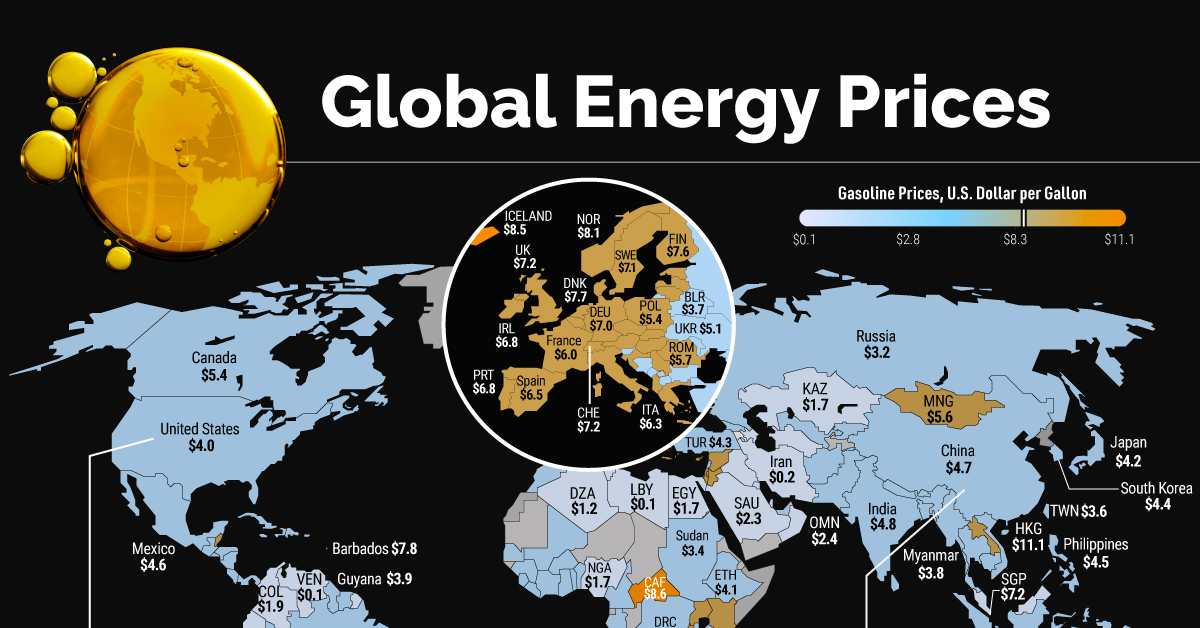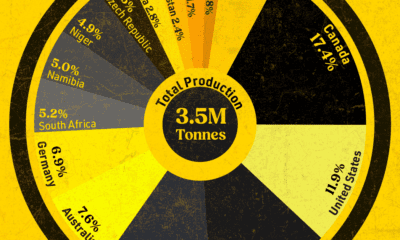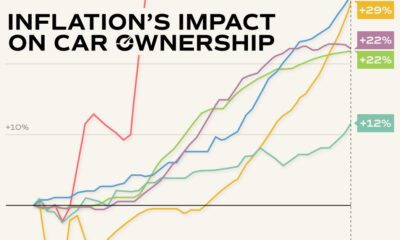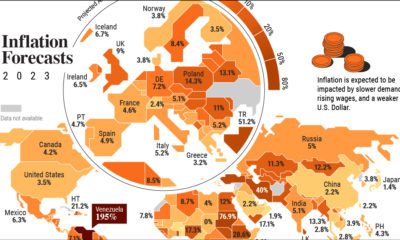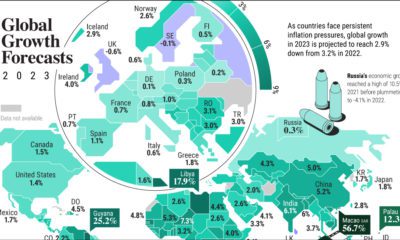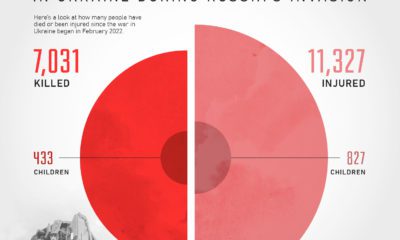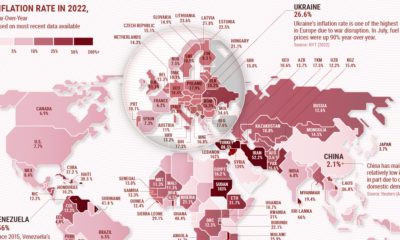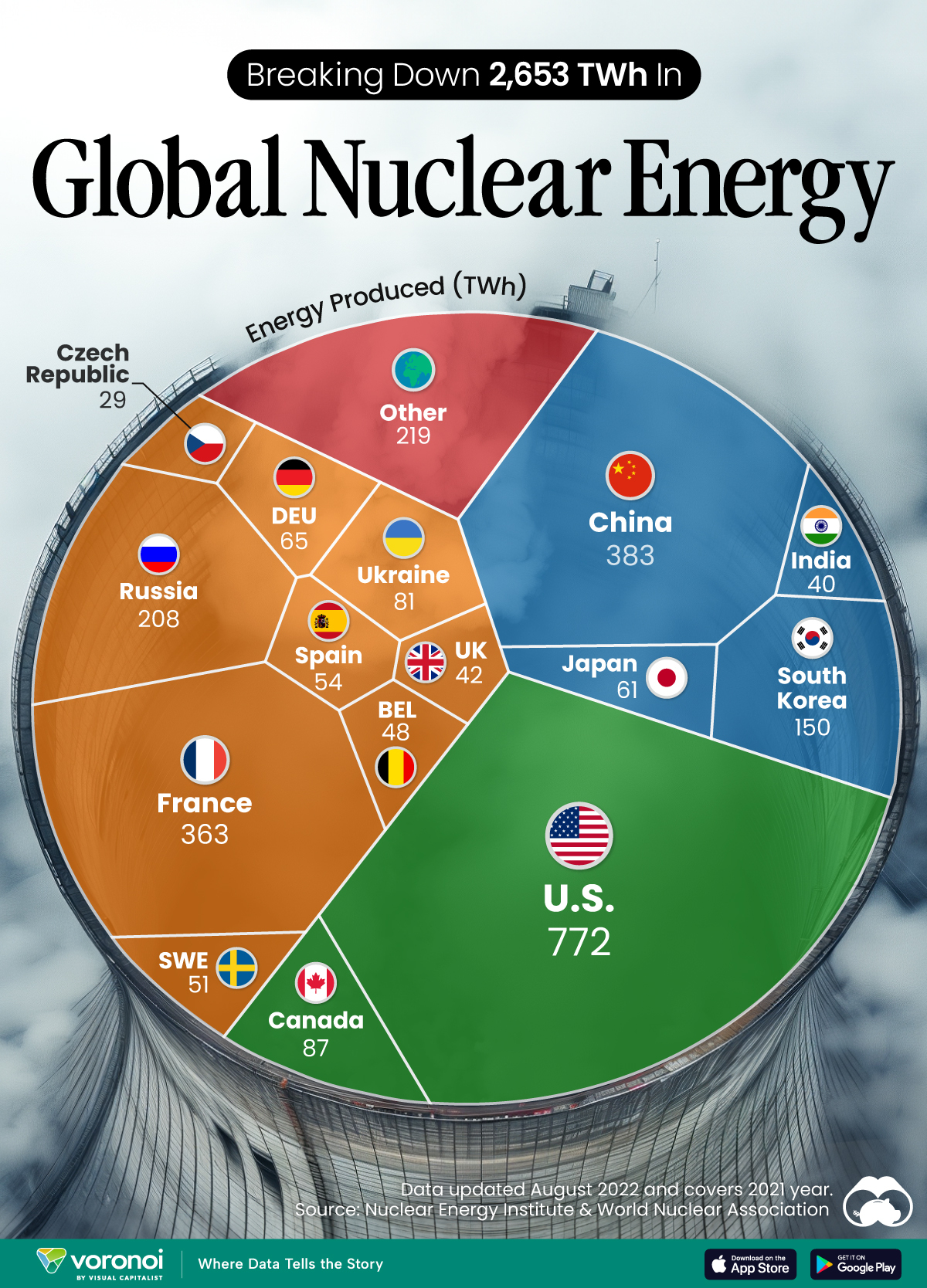Energy
Mapped: Global Energy Prices, by Country in 2022
How to use: Arrows on side navigate between each type of energy.
Mapped: Global Energy Prices, by Country in 2022
This was originally posted on Elements. Sign up to the free mailing list to get beautiful visualizations on natural resource megatrends in your email every week.
For some countries, energy prices hit historic levels in 2022.
Gasoline, electricity, and natural gas prices skyrocketed as Russia’s invasion of Ukraine ruptured global energy supply chains. Households and businesses are facing higher energy bills amid extreme price volatility. Uncertainty surrounding the war looms large, and winter heating costs are projected to soar.
Given the global consequences of the energy crisis, the above infographic shows the price of energy for households by country, with data from GlobalPetrolPrices.com.
1. Global Energy Prices: Gasoline
Which countries and regions pay the most for a gallon of gas?
| Rank | Country/ Region | Gasoline Prices (USD per Gallon) |
|---|---|---|
| 1 | 🇭🇰 Hong Kong | $11.1 |
| 2 | 🇨🇫 Central African Republic | $8.6 |
| 3 | 🇮🇸 Iceland | $8.5 |
| 4 | 🇳🇴 Norway | $8.1 |
| 5 | 🇧🇧 Barbados | $7.8 |
| 6 | 🇩🇰 Denmark | $7.7 |
| 7 | 🇬🇷 Greece | $7.6 |
| 8 | 🇫🇮 Finland | $7.6 |
| 9 | 🇳🇱 Netherlands | $7.6 |
| 10 | 🇧🇪 Belgium | $7.4 |
| 11 | 🇬🇧 United Kingdom | $7.2 |
| 12 | 🇪🇪 Estonia | $7.2 |
| 13 | 🇨🇭 Switzerland | $7.2 |
| 14 | 🇸🇬 Singapore | $7.2 |
| 15 | 🇸🇪 Sweden | $7.1 |
| 16 | 🇸🇨 Seychelles | $7.1 |
| 17 | 🇮🇱 Israel | $7.0 |
| 18 | 🇩🇪 Germany | $7.0 |
| 19 | 🇺🇾 Uruguay | $7.0 |
| 20 | 🇼🇫 Wallis and Futuna | $7.0 |
| 21 | 🇱🇮 Liechtenstein | $6.9 |
| 22 | 🇮🇪 Ireland | $6.8 |
| 23 | 🇵🇹 Portugal | $6.8 |
| 24 | 🇱🇻 Latvia | $6.7 |
| 25 | 🇧🇿 Belize | $6.7 |
| 26 | 🇦🇱 Albania | $6.6 |
| 27 | 🇦🇹 Austria | $6.6 |
| 28 | 🇲🇨 Monaco | $6.6 |
| 29 | 🇪🇸 Spain | $6.5 |
| 30 | 🇨🇿 Czech Republic | $6.5 |
| 31 | 🇲🇼 Malawi | $6.5 |
| 32 | 🇰🇾 Cayman Islands | $6.4 |
| 33 | 🇸🇰 Slovakia | $6.4 |
| 34 | 🇲🇺 Mauritius | $6.3 |
| 35 | 🇱🇺 Luxembourg | $6.3 |
| 36 | 🇱🇹 Lithuania | $6.3 |
| 37 | 🇦🇩 Andorra | $6.3 |
| 38 | 🇮🇹 Italy | $6.3 |
| 39 | 🇺🇬 Uganda | $6.2 |
| 40 | 🇭🇺 Hungary | $6.2 |
| 41 | 🇯🇴 Jordan | $6.2 |
| 42 | 🇸🇾 Syria | $6.1 |
| 43 | 🇫🇷 France | $6.0 |
| 44 | 🇧🇮 Burundi | $6.0 |
| 45 | 🇧🇸 Bahamas | $6.0 |
| 46 | 🇳🇿 New Zealand | $5.8 |
| 47 | 🇸🇲 San Marino | $5.8 |
| 48 | 🇭🇷 Croatia | $5.8 |
| 49 | 🇷🇴 Romania | $5.7 |
| 50 | 🇾🇹 Mayotte | $5.7 |
| 51 | 🇷🇼 Rwanda | $5.7 |
| 52 | 🇿🇲 Zambia | $5.7 |
| 53 | 🇷🇸 Serbia | $5.7 |
| 54 | 🇱🇦 Laos | $5.6 |
| 55 | 🇲🇳 Mongolia | $5.6 |
| 56 | 🇰🇪 Kenya | $5.6 |
| 57 | 🇨🇾 Cyprus | $5.6 |
| 58 | 🇯🇲 Jamaica | $5.5 |
| 59 | 🇲🇰 Northern Macedonia | $5.5 |
| 60 | 🇨🇱 Chile | $5.5 |
| 61 | 🇧🇦 Bosnia | $5.5 |
| 62 | 🇱🇨 Saint Lucia | $5.4 |
| 63 | 🇵🇱 Poland | $5.4 |
| 64 | 🇩🇴 Dominican Republic | $5.4 |
| 65 | 🇨🇦 Canada | $5.4 |
| 66 | 🇲🇦 Morocco | $5.4 |
| 67 | 🇦🇼 Aruba | $5.4 |
| 68 | 🇸🇮 Slovenia | $5.3 |
| 69 | 🇧🇬 Bulgaria | $5.3 |
| 70 | 🇵🇪 Peru | $5.3 |
| 71 | 🇱🇰 Sri Lanka | $5.3 |
| 72 | 🇨🇷 Costa Rica | $5.2 |
| 73 | 🇲🇬 Madagascar | $5.2 |
| 74 | 🇬🇳 Guinea | $5.2 |
| 75 | 🇳🇵 Nepal | $5.2 |
| 76 | 🇲🇿 Mozambique | $5.2 |
| 77 | 🇳🇮 Nicaragua | $5.2 |
| 78 | 🇲🇱 Mali | $5.1 |
| 79 | 🇸🇳 Senegal | $5.1 |
| 80 | 🇺🇦 Ukraine | $5.1 |
| 81 | 🇩🇲 Dominica | $5.0 |
| 82 | 🇲🇪 Montenegro | $5.0 |
| 83 | 🇲🇹 Malta | $5.0 |
| 84 | 🇲🇩 Moldova | $5.0 |
| 85 | 🇨🇩 DR Congo | $5.0 |
| 86 | 🇨🇼 Curacao | $4.9 |
| 87 | 🇨🇻 Cape Verde | $4.9 |
| 88 | 🇧🇩 Bangladesh | $4.9 |
| 89 | 🇱🇷 Liberia | $4.8 |
| 90 | 🇰🇭 Cambodia | $4.8 |
| 91 | 🇮🇳 India | $4.8 |
| 92 | 🇨🇺 Cuba | $4.8 |
| 93 | 🇭🇳 Honduras | $4.7 |
| 94 | 🇬🇪 Georgia | $4.7 |
| 95 | 🇿🇦 South Africa | $4.7 |
| 96 | 🇹🇿 Tanzania | $4.7 |
| 97 | 🇫🇯 Fiji | $4.7 |
| 98 | 🇨🇳 China | $4.7 |
| 99 | 🇲🇽 Mexico | $4.6 |
| 100 | 🇬🇹 Guatemala | $4.6 |
Source: GlobalPetrolPrices.com. As of October 31, 2022. Represents average household prices.
At an average $11.10 per gallon, households in Hong Kong pay the highest for gasoline in the world—more than double the global average. Both high gas taxes and steep land costs are primary factors behind high gas prices.
Like Hong Kong, the Central African Republic has high gas costs, at $8.60 per gallon. As a net importer of gasoline, the country has faced increased price pressures since the war in Ukraine.
Households in Iceland, Norway, and Denmark face the highest gasoline costs in Europe. Overall, Europe has seen inflation hit 10% in September, driven by the energy crisis.
2. Global Energy Prices: Electricity
Extreme volatility is also being seen in electricity prices.
The majority of the highest household electricity prices are in Europe, where Denmark, Germany, and Belgium’s prices are about double that of France and Greece. For perspective, electricity prices in many countries in Europe are more than twice or three times the global average of $0.14 per kilowatt-hour.
Over the first quarter of 2022, household electricity prices in the European Union jumped 32% compared to the year before.
| Rank | Country/ Region | Electricity Prices (kWh, USD) |
|---|---|---|
| 1 | 🇩🇰 Denmark | $0.46 |
| 2 | 🇩🇪 Germany | $0.44 |
| 3 | 🇧🇪 Belgium | $0.41 |
| 4 | 🇧🇲 Bermuda | $0.40 |
| 5 | 🇰🇾 Cayman Islands | $0.35 |
| 6 | 🇯🇲 Jamaica | $0.34 |
| 7 | 🇬🇧 United Kingdom | $0.32 |
| 8 | 🇪🇸 Spain | $0.32 |
| 9 | 🇳🇱 Netherlands | $0.32 |
| 10 | 🇧🇧 Barbados | $0.32 |
| 11 | 🇪🇪 Estonia | $0.32 |
| 12 | 🇱🇹 Lithuania | $0.31 |
| 13 | 🇦🇹 Austria | $0.31 |
| 14 | 🇮🇹 Italy | $0.30 |
| 15 | 🇨🇿 Czech Republic | $0.29 |
| 16 | 🇨🇻 Cape Verde | $0.28 |
| 17 | 🇮🇪 Ireland | $0.28 |
| 18 | 🇸🇪 Sweden | $0.27 |
| 19 | 🇧🇸 Bahamas | $0.26 |
| 20 | 🇬🇹 Guatemala | $0.26 |
| 21 | 🇱🇮 Liechtenstein | $0.26 |
| 22 | 🇨🇾 Cyprus | $0.25 |
| 23 | 🇷🇼 Rwanda | $0.25 |
| 24 | 🇭🇳 Honduras | $0.24 |
| 25 | 🇺🇾 Uruguay | $0.24 |
| 26 | 🇵🇹 Portugal | $0.24 |
| 27 | 🇸🇻 El Salvador | $0.23 |
| 28 | 🇱🇻 Latvia | $0.22 |
| 29 | 🇫🇮 Finland | $0.22 |
| 30 | 🇱🇺 Luxembourg | $0.22 |
| 31 | 🇧🇿 Belize | $0.22 |
| 32 | 🇯🇵 Japan | $0.22 |
| 33 | 🇨🇭 Switzerland | $0.22 |
| 34 | 🇵🇪 Peru | $0.21 |
| 35 | 🇰🇪 Kenya | $0.21 |
| 36 | 🇦🇺 Australia | $0.21 |
| 37 | 🇧🇷 Brazil | $0.20 |
| 38 | 🇲🇱 Mali | $0.20 |
| 39 | 🇸🇬 Singapore | $0.19 |
| 40 | 🇷🇴 Romania | $0.19 |
| 41 | 🇧🇫 Burkina Faso | $0.19 |
| 42 | 🇸🇮 Slovenia | $0.19 |
| 43 | 🇬🇦 Gabon | $0.19 |
| 44 | 🇸🇰 Slovakia | $0.19 |
| 45 | 🇦🇼 Aruba | $0.19 |
| 46 | 🇬🇷 Greece | $0.19 |
| 47 | 🇫🇷 France | $0.18 |
| 48 | 🇳🇿 New Zealand | $0.18 |
| 49 | 🇹🇬 Togo | $0.18 |
| 50 | 🇳🇮 Nicaragua | $0.17 |
| 51 | 🇻🇪 Venezuela | $0.17 |
| 52 | 🇵🇦 Panama | $0.17 |
| 53 | 🇵🇭 Philippines | $0.17 |
| 54 | 🇵🇱 Poland | $0.17 |
| 55 | 🇮🇱 Israel | $0.16 |
| 56 | 🇺🇲 U.S. | $0.16 |
| 57 | 🇺🇬 Uganda | $0.16 |
| 58 | 🇭🇰 Hong Kong | $0.16 |
| 59 | 🇸🇳 Senegal | $0.16 |
| 60 | 🇲🇴 Macao | $0.15 |
| 61 | 🇨🇱 Chile | $0.15 |
| 62 | 🇰🇭 Cambodia | $0.15 |
| 63 | 🇿🇦 South Africa | $0.14 |
| 64 | 🇲🇺 Mauritius | $0.14 |
| 65 | 🇲🇬 Madagascar | $0.14 |
| 66 | 🇭🇷 Croatia | $0.14 |
| 67 | 🇮🇸 Iceland | $0.14 |
| 68 | 🇳🇴 Norway | $0.13 |
| 69 | 🇲🇹 Malta | $0.13 |
| 70 | 🇲🇿 Mozambique | $0.13 |
| 71 | 🇨🇴 Colombia | $0.13 |
| 72 | 🇧🇬 Bulgaria | $0.12 |
| 73 | 🇲🇻 Maldives | $0.12 |
| 74 | 🇨🇷 Costa Rica | $0.12 |
| 75 | 🇨🇦 Canada | $0.11 |
| 76 | 🇲🇼 Malawi | $0.11 |
| 77 | 🇨🇮 Ivory Coast | $0.11 |
| 78 | 🇳🇦 Namibia | $0.11 |
| 79 | 🇲🇦 Morocco | $0.11 |
| 80 | 🇹🇭 Thailand | $0.10 |
| 81 | 🇦🇲 Armenia | $0.10 |
| 82 | 🇯🇴 Jordan | $0.10 |
| 83 | 🇹🇿 Tanzania | $0.10 |
| 84 | 🇸🇿 Swaziland | $0.10 |
| 85 | 🇪🇨 Ecuador | $0.10 |
| 86 | 🇧🇼 Botswana | $0.10 |
| 87 | 🇩🇴 Dominican Republic | $0.10 |
| 88 | 🇲🇰 Northern Macedonia | $0.10 |
| 89 | 🇦🇱 Albania | $0.10 |
| 90 | 🇱🇸 Lesotho | $0.09 |
| 91 | 🇸🇱 Sierra Leone | $0.09 |
| 92 | 🇮🇩 Indonesia | $0.09 |
| 93 | 🇧🇾 Belarus | $0.09 |
| 94 | 🇭🇺 Hungary | $0.09 |
| 95 | 🇧🇦 Bosnia & Herzegovina | $0.09 |
| 96 | 🇹🇼 Taiwan | $0.09 |
| 97 | 🇰🇷 South Korea | $0.09 |
| 98 | 🇲🇽 Mexico | $0.09 |
| 99 | 🇷🇸 Serbia | $0.09 |
| 100 | 🇨🇩 DR Congo | $0.08 |
Source: GlobalPetrolPrices.com. As of March 31, 2022. Represents average household prices.
In the U.S., consumer electricity prices have increased nearly 16% annually compared to September last year, the highest increase in over four decades, fueling higher inflation.
However, households are more sheltered from the impact of Russian supply disruptions due to the U.S. being a net exporter of energy.
3. Global Energy Prices: Natural Gas
Eight of the 10 highest natural gas prices globally fall in Europe, with the Netherlands at the top. Overall, European natural gas prices have spiked sixfold in a year since the invasion of Ukraine.
| Rank | Country/ Region | Natural Gas Prices (kWh, USD) |
|---|---|---|
| 1 | 🇳🇱 Netherlands | $0.41 |
| 2 | 🇸🇪 Sweden | $0.24 |
| 3 | 🇩🇪 Germany | $0.21 |
| 4 | 🇧🇷 Brazil | $0.20 |
| 5 | 🇩🇰 Denmark | $0.19 |
| 6 | 🇪🇸 Spain | $0.17 |
| 7 | 🇮🇹 Italy | $0.16 |
| 8 | 🇦🇹 Austria | $0.16 |
| 9 | 🇸🇬 Singapore | $0.15 |
| 10 | 🇧🇪 Belgium | $0.15 |
| 11 | 🇭🇰 Hong Kong | $0.14 |
| 12 | 🇨🇿 Czech Republic | $0.14 |
| 13 | 🇬🇷 Greece | $0.12 |
| 14 | 🇫🇷 France | $0.12 |
| 15 | 🇯🇵 Japan | $0.11 |
| 16 | 🇬🇧 United Kingdom | $0.10 |
| 17 | 🇨🇭 Switzerland | $0.10 |
| 18 | 🇨🇱 Chile | $0.10 |
| 19 | 🇵🇹 Portugal | $0.09 |
| 20 | 🇧🇧 Barbados | $0.09 |
| 21 | 🇵🇱 Poland | $0.09 |
| 22 | 🇧🇬 Bulgaria | $0.09 |
| 23 | 🇮🇪 Ireland | $0.08 |
| 24 | 🇦🇺 Australia | $0.07 |
| 25 | 🇲🇽 Mexico | $0.07 |
| 26 | 🇳🇿 New Zealand | $0.06 |
| 27 | 🇸🇰 Slovakia | $0.06 |
| 28 | 🇺🇲 U.S. | $0.05 |
| 29 | 🇰🇷 South Korea | $0.04 |
| 30 | 🇨🇴 Colombia | $0.04 |
| 31 | 🇨🇦 Canada | $0.03 |
| 32 | 🇷🇸 Serbia | $0.03 |
| 33 | 🇹🇼 Taiwan | $0.03 |
| 34 | 🇺🇦 Ukraine | $0.03 |
| 35 | 🇲🇾 Malaysia | $0.03 |
| 36 | 🇭🇺 Hungary | $0.03 |
| 37 | 🇹🇳 Tunisia | $0.02 |
| 38 | 🇦🇿 Azerbaijan | $0.01 |
| 39 | 🇧🇭 Bahrain | $0.01 |
| 40 | 🇧🇩 Bangladesh | $0.01 |
| 41 | 🇹🇷 Turkey | $0.01 |
| 42 | 🇷🇺 Russia | $0.01 |
| 43 | 🇦🇷 Argentina | $0.01 |
| 44 | 🇧🇾 Belarus | $0.01 |
| 45 | 🇩🇿 Algeria | $0.00 |
| 46 | 🇮🇷 Iran | $0.00 |
Source: GlobalPetrolPrices.com. As of March 31, 2022. Represents average household prices.
The good news is that the fall season has been relatively warm, which has helped European natural gas demand drop 22% in October compared to last year. This helps reduce the risk of gas shortages transpiring later in the winter.
Outside of Europe, Brazil has the fourth highest natural gas prices globally, despite producing about half of supply domestically. High costs of cooking gas have been especially challenging for low-income families, which became a key political issue in the run-up to the presidential election in October.
Meanwhile, Singapore has the highest natural gas prices in Asia as the majority is imported via tankers or pipelines, leaving the country vulnerable to price shocks.
Increasing Competition
By December, all seaborne crude oil shipments from Russia to Europe will come to a halt, likely pushing up gasoline prices into the winter and 2023.
Concerningly, analysis from the EIA shows that European natural gas storage capacities could sink to 20% by February if Russia completely shuts off its supply and demand is not reduced.
As Europe seeks out alternatives to Russian energy, higher demand could increase global competition for fuel sources, driving up prices for energy in the coming months ahead.
Still, there is some room for optimism: the World Bank projects energy prices will decline 11% in 2023 after the 60% rise seen after the war in Ukraine in 2022.
Energy
The World’s Biggest Nuclear Energy Producers
China has grown its nuclear capacity over the last decade, now ranking second on the list of top nuclear energy producers.
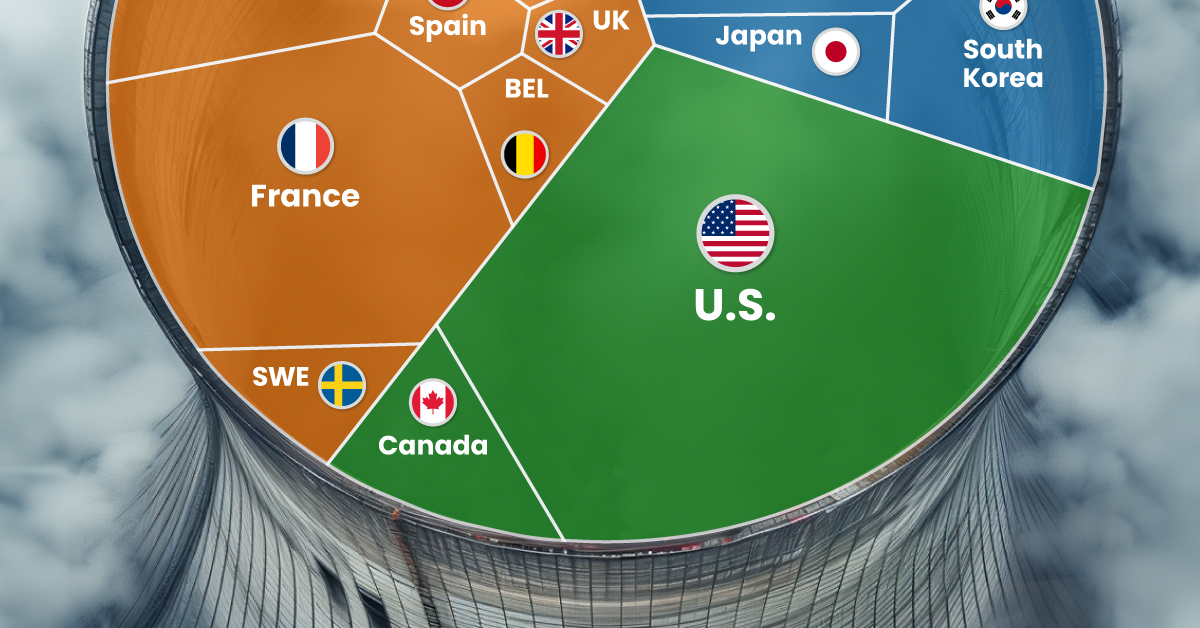
The World’s Biggest Nuclear Energy Producers
This was originally posted on our Voronoi app. Download the app for free on Apple or Android and discover incredible data-driven charts from a variety of trusted sources.
Scientists in South Korea recently broke a record in a nuclear fusion experiment. For 48 seconds, they sustained a temperature seven times that of the sun’s core.
But generating commercially viable energy from nuclear fusion still remains more science fiction than reality. Meanwhile, its more reliable sibling, nuclear fission, has been powering our world for many decades.
In this graphic, we visualized the top producers of nuclear energy by their share of the global total, measured in terawatt hours (TWh). Data for this was sourced from the Nuclear Energy Institute, last updated in August 2022.
Which Country Generates the Most Nuclear Energy?
Nuclear energy production in the U.S. is more than twice the amount produced by China (ranked second) and France (ranked third) put together. In total, the U.S. accounts for nearly 30% of global nuclear energy output.
However, nuclear power only accounts for one-fifth of America’s electricity supply. This is in contrast to France, which generates 60% of its electricity from nuclear plants.
| Rank | Country | Nuclear Energy Produced (TWh) | % of Total |
|---|---|---|---|
| 1 | 🇺🇸 U.S. | 772 | 29% |
| 2 | 🇨🇳 China | 383 | 14% |
| 3 | 🇫🇷 France | 363 | 14% |
| 4 | 🇷🇺 Russia | 208 | 8% |
| 5 | 🇰🇷 South Korea | 150 | 6% |
| 6 | 🇨🇦 Canada | 87 | 3% |
| 7 | 🇺🇦 Ukraine | 81 | 3% |
| 8 | 🇩🇪 Germany | 65 | 2% |
| 9 | 🇯🇵 Japan | 61 | 2% |
| 10 | 🇪🇸 Spain | 54 | 2% |
| 11 | 🇸🇪 Sweden | 51 | 2% |
| 12 | 🇧🇪 Belgium | 48 | 2% |
| 13 | 🇬🇧 UK | 42 | 2% |
| 14 | 🇮🇳 India | 40 | 2% |
| 15 | 🇨🇿 Czech Republic | 29 | 1% |
| N/A | 🌐 Other | 219 | 8% |
| N/A | 🌍 Total | 2,653 | 100% |
Another highlight is how China has rapidly grown its nuclear energy capabilities in the last decade. Between 2016 and 2021, for example, it increased its share of global nuclear energy output from less than 10% to more than 14%, overtaking France for second place.
On the opposite end, the UK’s share has slipped to 2% over the same time period.
Meanwhile, Ukraine has heavily relied on nuclear energy to power its grid. In March 2022, it lost access to its key Zaporizhzhia Nuclear Power Station after Russian forces wrested control of the facility. With six 1,000 MW reactors, the plant is one of the largest in Europe. It is currently not producing any power, and has been the site of recent drone attacks.
-

 Green2 weeks ago
Green2 weeks agoRanked: Top Countries by Total Forest Loss Since 2001
-

 Travel1 week ago
Travel1 week agoRanked: The World’s Top Flight Routes, by Revenue
-

 Technology1 week ago
Technology1 week agoRanked: Semiconductor Companies by Industry Revenue Share
-

 Money2 weeks ago
Money2 weeks agoWhich States Have the Highest Minimum Wage in America?
-

 Real Estate2 weeks ago
Real Estate2 weeks agoRanked: The Most Valuable Housing Markets in America
-

 Markets2 weeks ago
Markets2 weeks agoCharted: Big Four Market Share by S&P 500 Audits
-

 AI2 weeks ago
AI2 weeks agoThe Stock Performance of U.S. Chipmakers So Far in 2024
-

 Automotive2 weeks ago
Automotive2 weeks agoAlmost Every EV Stock is Down After Q1 2024


